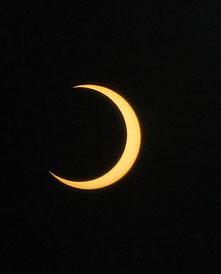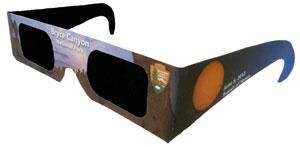Sunday afternoon May 20, 2012 will offer a Celestial Super Bowl'a near-total solar eclipse'and parks in parts of the western U.S. will offer some prime viewing locations. If you want to make travel plans for special eclipse-related activities or purchase equipment for safe viewing, just don't wait too long to do so.
In anticipation of the event, the National Park Service has released information about parks which offer the chance to combine a glimpse of the event with a fine setting. A NPS spokesperson notes that about 30 park sites will be on or near a line for "premier viewing;" another 125 NPS areas in 22 states lie in locations offering "wonderful" eclipse views.
While it's true you can enjoy the event from any site that will lie within the path of the moon's shadow as it passes across the earth'assuming the weather cooperates'the setting can add to the experience. As an NPS spokesperson points out, "Imagine the moon eclipsing the sun with Old Faithful in the foreground, or the Golden Gate Bridge or any other icon of the west framing the eclipse." Such settings definitely offer a plus when compared with the view of an eclipse over a shopping mall parking lot!
Best Parks for Viewing the Eclipse
So... where can you combine an eclipse sighting with a park setting? A view of the moon centered on and covering more than 96 percent of the sun will be visible late in the day to near sunset at six national parks:
'¢ Petroglyph National Monument
'¢ Redwoods National Park (where the best view will be on the beach)
'¢ Lassen Volcanic National Park
'¢ Canyon de Chelly National Monument
'¢ Glen Canyon National Recreation Area
An NPS spokesperson says visitors at Petroglyph National Monument in New Mexico "will see the moon centered, and covering 96.5 percent of the sun. This period of 'annularity' will last four minutes and 26 seconds beginning at 7:33 p.m. MDT. Since this won't be a total eclipse, there will be a bright ring of light surrounding the moon. For viewers at Petroglyph, the eclipse will be over as the sun slips below the horizon at about 8:30 p.m."
A handy map showing NPS areas where the best views of the eclipse will be visible, along with starting and ending times of the event, is available at this link. Details overlaid on the map for several parks also include a small drawing depicting how the sun will appear during the peak of the eclipse at that location. After you open this .pdf document, scroll down to the map on page three and right-click with your mouse to rotate the map to a horizontal view.
Another handy tool for plotting a viewing strategy is available on an interactive map posted by NASA, which overlays the path of the moon's shadow on a Google map. You can drag a "pointer" to any spot on the map for details on the starting and ending time for the eclipse at that location.
Altogether, there are more than 150 national parks in the Western U.S. and Alaska which will offer a view of at least a partial eclipse. You'll find a complete list here.
Special Eclipse-Viewing Events in Parks

This phase of an annular solar eclipse was visible from India in 2010, and offers a preview of what can be seen from some sites in the U. S. this May. Photo by sudhamshu via Creative Commons and flickr.
A number of parks are planning special activities to facilitate viewing the eclipse, and at many locations, the events will continue into the evening for star-gazing. At Bryce Canyon National Park, for example, the park's 12th annual Astronomy Festival will run from May 17-20, culminating with eclipse-viewing activities on the 20th.
Kevin Poe, the "dark ranger" at Bryce Canyon National Park, said the park staff decided to move the dates of their annual astronomy festival to take advantage of the May 20 eclipse, even though another very unusual celestial event'the Venus Transit'is coming up on June 5th.
"It (the eclipse) is not nearly as rare, or as scientifically interesting as the Venus Transit ... But it's just so much more dramatic and sexy that we decided to focus on the eclipse rather than the Venus Transit as our big event of the year," Poe said."
"On average you get a solar eclipse over any section of the planet about once ever 50 years. And, that's a rough average. The next one through North America is 2017, and it's quite a bit further north; the line actually runs through (Grand) Teton and into northern Oregon for that one."
"Hard-core astronomers will tell you that an annular eclipse, which this one is going to be, is, I think the line I keep hearing strangely enough, is it's like kissing your sister. They kind of just talk down a little bit about how it's not as cool as a total eclipse, where the Moon is close enough to Earth that it completely blocks the Sun. Nevertheless," Poe continued, "as far as sheer visual appeal, these things are spectacular because you have the ring of fire hanging over the sky. And even though it doesn't get as dark as a complete eclipse, it's a really neat thing to observe for those five critical minutes.'
Curious about the Venus Transit? Check back with the Traveler tomorrow for more details on that truly rare event.
Glen Canyon National Recreation Area will be one of the NPS sites closest to the "center-line" on a map of best viewing areas and is staging a 3-day "Annular Eclipse Festival" on May 18-20. On the South Rim at Grand Canyon National Park, the Tucson Amateur Astronomy Association will be sharing their solar telescopes with the public both during the eclipse and after dark for a one-night "Star Party." Yet another location within the "prime" viewing area that also offers excellent night-sky resources year-round is Great Basin National Park.
You'll find a list of other park-based eclipse events at this link. If you're considering a trip to see the eclipse, what might you see from the best sites? According to the NPS, "Visitors at national parks along the central path of the solar eclipse may witness a 'ring of fire' as the moon covers 95 percent of the sun. This bullseye in the sky is an uncommon celestial event, prized by photographers, astronomy buffs and nature lovers."
Viewing an Eclipse Safely
That summary also prompts a word of caution. Since this will not be a total eclipse, it's essential that all viewers keep safety guidelines in mind. A NASA website points out that "It is never safe to look at a partial or annular eclipse, or the partial phases of a total solar eclipse, without the proper equipment and techniques. Even when 99% of the Sun's surface '¦ is obscured during the partial phases of a solar eclipse, the remaining crescent Sun is still intense enough to cause a retinal burn, even though illumination levels are comparable to twilight." You'll find tips on safe eclipse viewing here.

"Solar filter glasses" will be available, while supplies last, at Bryce Canyon National Park on May 20. They are one way to view the eclipse safely. Image from Bryce Canyon National Park.
There's plenty of information on this subject on the web, and several astronomy sites offer a word of caution: some suppliers of the special filters needed for using cameras, telescopes and binoculars for eclipse viewing are already showing some items on backorder. As time for the eclipse draws near, the same will likely apply to the inexpensive but effective "eclipse glasses" or "solar filter glasses" for safe viewing. Some park bookstores and similar sites have them for sale, but it would be wise to line up your equipment ahead of time to avoid disappointment'and the temptation to just "take a peek" and suffer long-term eye damage.
Annular, Partial and Total - Eclipse Terminology
Perhaps it's been a while since your last science class, so if you're puzzling about why some eclipses are "total" while others are "annular" or "partial," you'll find some unusually clear and succinct explanations about the subject at this site. The NPS also offers the following summary:
"Partial solar eclipses (where the moon 'takes a bite' out of the sun) are somewhat common, occurring about twice a year somewhere on the globe. Total solar eclipses, when the moon completely blocks out the sun for a few minutes, are less common. And when the moon is swinging far in its orbit and appears smaller, it isn't large enough to completely blot out the sun, resulting in an annular eclipse. The last time an annular solar eclipse was seen in the contiguous U.S. was 1994." The event coming up this May will be an annular eclipse.
If you miss this sky party, the next partial solar eclipse visible in at least part of North America will be on October 23, 2014. For the really big show'a total solar eclipse visible from the parts of the U. S. mainland'the next opportunity comes around on August 21, 2017.
Finally, here's a tidbit that adds just a little extra interest to the upcoming eclipse: it will span portions of two days, with time seemingly running in reverse. As the moon's shadow races across the face of the earth, the eclipse will first be visible in China, on the 21st of May in local time zones. As the shadow progresses eastward, it will cross the International Date Line, making the eclipse visible a day earlier'on the 20th of May local time'in the southwestern United States. A NASA site offers an animated depiction of the moon's shadow as it passes across the earth from China to the United States.
So set your watch'and check your calendar'and make your travel plans if you want to venture to one of those prime locations. This event could provide a welcome economic stimulus plan for some communities in the right location... but there aren't an unlimited number of motel rooms in Page, Arizona.


 Support Essential Coverage of Essential Places
Support Essential Coverage of Essential Places







Comments
Thanks for all the cool links! Got it on my calendar now.
Wow! I was going to put off NPS trips this year due to home improvement projects, but now I am second-guessing that decision ...
i love your pics
Thank you for the information about the solar eclipse! It sounds like a very exciting event that I'm looking forward to seeing. Thank you for also offering information about the safety precautions that we should take when viewing the eclipse. I will definitely mark my calender for this event!